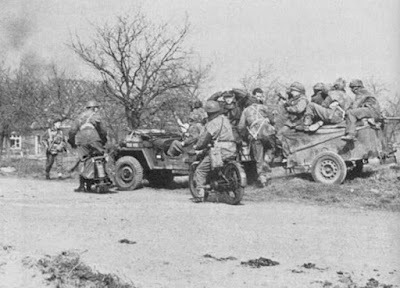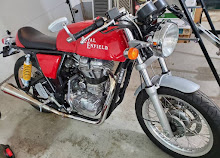 |
| Royal Enfield Flying Flea pauses as British airborne soldiers cross the Rhine in 1945. |
But there the Flying Fleas seemed to have stopped. I've only found one photo, above, that shows a Flying Flea being ridden in a battle zone.
What happened to them? There is a theory: maybe the soldiers had trouble getting them started.
Here's how I encountered this explanation. I wrote a blog item about how the Royal Enfield Flying Flea was originally created for the civilian market, dubbed the Royal Baby.
For that article I wanted some proof that Flying Flea motorcycles actually made it into battle. I found a diagram showing how to load a British Airspeed Horsa glider with a Jeep and its trailer, an anti-aircraft gun, and a "MC, LT, WT, ROYAL ENFIELD." That's a Flying Flea.
The diagram shows a single Royal Enfield, jammed in sideways alongside the tongue of the Jeep trailer. (Other gliders would be loaded differently, of course, and may have brought more Royal Enfields. Many, of course, only carried soldiers.)
 |
| Loading diagram shows a Royal Enfield Flying Flea at left. (paradata.org.uk) |
Their answer surprised me.
It was this: in some cases the method of packing the motorcycles hindered their use in combat. Too much packing material was a bother to remove, and there was a device, meant to prevent fuel leaking in transport, that troops did not open.
"Although the bike would start, it eventually stopped working," I was told.
This encouraged me to raise the question with the Historical Military Vehicle Forum, where technical matters are often discussed. Member "Ron" had this response:
"David you must be referring to the air bleed button on the petrol filler cap, which must be released before starting to avoid a vacuum in the tank." And he attached a photo of what the button looked like.
 |
| Fuel filler is at right, with "air bleed button" sticking out of it. |
Perhaps the filler cap vent had always been opened during training and the soldier never realized what would happen if it was left closed for transport.
I'd read elsewhere that one of the special changes made in the civilian Royal Baby to make it a military motorcycle was the addition of a "vent sealed fuel filler."
It's exactly the sort of thing you overlook when you're in a hurry. How many times have I failed to move the kill switch button on my 1999 Royal Enfield Bullet to "Run"? Kick as I might, it won't start. It's right there in front of my eyes! And, yet, so easy to forget.
Sometimes all worked out as intended. It must have. Both my contact at Airborne Assault and Ron at HMVF provided the photo of the Flying Flea at the top of this article. It shows a Royal Enfield Flying Flea (and another, heavier motorcycle).
 |
| Close-up of Flying Flea with airborne soldiers. |
This was during Operation Varsity, the airborne crossing of the Rhine River. Notice that the soldiers have a German soldier in custody, hands behind his head.
And the Flying Flea was there.




























Great article David.
ReplyDelete